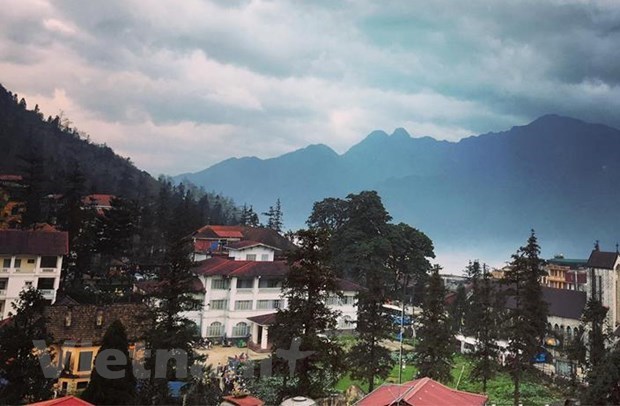Sa Pa: how to keep its charm as "City in the fog"
 Tourists at ancient church in the centre of Sa Pa town
Tourists at ancient church in the centre of Sa Pa town
Hanoi (VNA) - In the eyes of international visitors, Sa Pa is known as an ancient city covered in fog with a pedestrian walkway through picturesque terraced fields.
Over 100 years have passed since the French discovered the city, Sa Pa is nowadays known as one of the most attractive destinations for foreigners in Vietnam. In the eyes of international visitors, Sa Pa is known as an ancient city covered in fog with a pedestrian walkway through picturesque terraced fields.
Recently, the rampant construction and tourist harassment have made many tourists disappointed. However, a number of visitors still hailed Sa Pa as an unique destination, saying that Sa Pa will be more wonderful if it does not overexploit tourism.
Sa Pa - City in the fog
According to history books, Sa Pa was originally called Hung Ho, meaning Red Stream. French colonialists attacked Lao Cai in March 1886 and occupied Sa Pa in November that year. After conquering Hung Ho, realising the wonderful climate of this land, the French built many facilities to turn the place into a resort for hot summer months.
The natural landscape of Sa Pa with the mountains and the green color of forests is combined with human creativity to create a picture arranged in a harmonious layout.
Shrouded in floating clouds, Sa Pa is like a city in the fog. The cool and fresh climate here is an invaluable asset. Located at an average altitude of 1,500-1,800m, Sa Pa has a temperate climate, with an average temperature of 15-18 degrees Celsius. From May to August, there are a lot of rains.
Coming to Sa Pa in the cold season, if lucky visitors will have the opportunity to see falling snow, creating a beautiful scenery like a water-color painting.
Spring is the most beautiful season in Sa Pa as clouds and fog create a scenery that few places in Vietnam have.
April and May are the time when ethnic minorities plant rice on terraced fields. It is also a blooming season of many kinds of beautiful flowers. All combine to form a colorful picture. In the summer, Sa Pa is an ideal place to escape from the hot sun.
September and October are ripe rice season which fills every corner in bright yellow. At this time, Sa Pa seemed to put on a new color - yellow on all the hills.
The miraculous transformation of nature and climate in Sa Pa along with unique cultural identity of the northwest are enchanting to visitors.
Attractive destinations in Sa Pa
When it comes to discover Sa Pa, travellers should not miss the opportunity to conquer "the roof of Indochina”. Fansipan is the highest peak in Indochina (3,143m). It is about 9km to the southwest of Sa Pa.
If you are not an adventurer, you could use Fansipan cable line system. On the way to the top of the mountain, visitors could discover the fascinating flora and fauna of the Hoang Lien mountain range.
 A corner of Sa Pa (Photo: VietnamPlus)
A corner of Sa Pa (Photo: VietnamPlus) Near Sa Pa city, visitors could walk to Ham Rong mountain. Standing on the top of Ham Rong mountain, you can enjoy a panorama of Sa Pa, Muong Hoa valley, and Ta Phin village hidden in the smoky fog. Thanks to human hands, Ham Rong has been transformed into a fairy garden with shrouding clouds and flowers blooming on the ground.
In the centre of Sa Pa city is a stone church built in 1895, which is the most complete ancient architectural work left by the French. The church has been restored and preserved, becoming an indispensable image of the foggy city.
Apart from Hoang Lien Son mountain range, Sa Pa also attracts visitors thanks to Muong Hoa valley with winding terraced fields, Cat Cat village of Mong people, Ta Phin of Dao Do people, or Heaven Gate, Silver Waterfall.
Muong Hoa valley in Hau Thao commune is about 8km southeast of Sa Pa town. From Sa Pa, going through a pass along a high mountain range, you will come to Muong Hoa valley. A special site here is an ancient rock ground. The rocks here are carved with various shapes, which lie among the trees and terraced fields of ethnic minorities. Hundreds of sandstones with engraved drawings and strange characters have not been identified yet.
Today, this ancient rock area has been classified as a national relic site and unique heritage of ancient Vietnamese people. In Muong Hoa valley, there is also a beautiful small stream stretching about 15 km, passing through communes of Lao Chai, Ta Van and Hau Thao and ending in Ban Ho.
 Homestay model in Ta Van commune, Sa Pa attracts tourists
Homestay model in Ta Van commune, Sa Pa attracts tourists Maintaining the charm of Sa Pa
Sa Pa is magically beautiful and a beautiful landscape picture. However, rampant construction is turning this charming old town into a great construction site.
Local authorities are working to address the situation to preserve the natural and wild beauty of Sa Pa.
According to the Resolution by the National Assembly Standing Committee, Sa Pa district was upgraded into Sa Pa township in Lao Cai province on January 1, 2020.
In the near future, Lao Cai will have Sa Pa airport to “open” the sky, taking tourists nationwide to the foggy city.
Transport infrastructure is receiving a big amount of investment capital, with an expressway linking Hanoi-Lao Cai with Sa Pa worth over 2.5 trillion VND, which will be completed this year, removing traffic barriers to welcome visitors back to Sa Pa in a rapid and convenient manner.
The push of airport infrastructure will help Sa Pa tourism industry grow faster, aiming to reach the goal of 8 million visitors by 2030.
How to make visitors stay longer instead of disappointing them, how to make them share interesting stories about this place is a question for managers in Sa Pa./.












